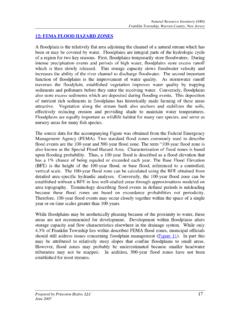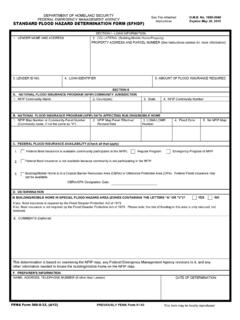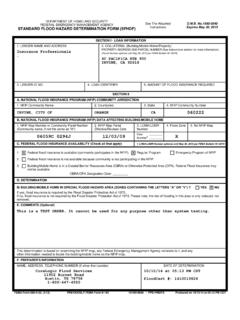Transcription of Introduction to the National Flood Insurance Program (NFIP)
1 Introduction to the National Flood Insurance Program (NFIP). Diane P. Horn Analyst in Flood Insurance and Emergency Management Jared T. Brown Analyst in Emergency Management and Homeland Security Policy April 30, 2018. Congressional Research Service 7-5700. R44593. Introduction to the National Flood Insurance Program (NFIP). Summary The NFIP was established by the National Flood Insurance Act of 1968 (NFIA, 42 4001. et seq.), and was most recently reauthorized to July 31, 2018, through a series of short-term reauthorizations. The general purpose of the NFIP is both to offer primary Flood Insurance to properties with significant Flood risk, and to reduce Flood risk through the adoption of floodplain management standards. Communities volunteer to participate in the NFIP in order to have access to federal Flood Insurance , and in return are required to adopt minimum standards.
2 FEMA manages a process, called Risk MAP, to produce Flood Insurance Rate Maps (FIRMs). Depicted on FIRMs are Special Flood Hazard Areas (SFHAs), which is the area exposed to a 1%. or greater risk of annual flooding. FIRMs vary in age across the country, and are updated on a prioritized basis. The Risk MAP process provides extensive outreach and appeal opportunities for communities. Updating a community's FIRMs can take three to five years or more. Participating communities must adopt a Flood map and enact minimum floodplain standards to regulate development in the SFHA. FEMA encourages communities to enhance their floodplain standards by offering reduced premium rates through the Community Rating System (CRS). FEMA also manages a Flood Mitigation Assistance (FMA) grant Program using NFIP revenues to further reduce comprehensive Flood risk.
3 NFIP Insurance uses one of three types of Standard Flood Insurance Policies (SFIPs). SFIPs have maximum coverage limits set by law. Any federal entity that makes, guarantees, or purchases mortgages must, by law, require property owners in the SFHA to purchase Flood Insurance , generally through the NFIP. In moderate risk areas, community members may purchase Preferred Risk Policies (PRPs) that offer less costly Insurance . The day-to-day sale, servicing, and claims processing of NFIP policies are conducted by private industry partners. Most policies are serviced by companies that are reimbursed through the Write Your Own (WYO) Program . The premium rate for most NFIP policies is intended to reflect the true Flood risk. However, Congress has directed FEMA to subsidize Flood Insurance for properties built before the community's first FIRM ( , the pre-FIRM subsidy).
4 In addition, FEMA grandfathers . properties at their rate from past FIRMs to updated FIRMs through a cross-subsidy. Congress also directed the development of an Affordability Study, and a forthcoming Draft Affordability Framework, to evaluate methods for making Flood Insurance more affordable. Participating communities that fail to adopt FIRMs or maintain minimum floodplain standards can be put on probation or suspended from the NFIP. In communities that do not participate in the NFIP, or have been suspended, individuals cannot purchase NFIP Insurance . Individuals in these communities also face challenges receiving federal disaster assistance in Flood hazard areas, and have difficulties receiving federally backed mortgages. Congress has provided appropriations to the NFIP for some of the cost of Risk MAP. Congress also authorizes the use of premium revenues for other NFIP costs, including administration, salaries, and other expenses.
5 NFIP premiums also include other charges, such as a Federal Policy Fee, a Reserve Fund assessment, and a surcharge to help fund the NFIP. In October 2017, Congress cancelled $16 billion of NFIP debt, making it possible for the Program to pay claims for Hurricanes Harvey, Irma, and Maria. The NFIP currently owes $ billion to the Treasury, leaving $ billion in borrowing authority from a $ billion limit in law. This debt is serviced by the NFIP and interest is paid through premium revenues. After July 31, 2018, key authorities of the NFIP, such as the authority to issue new Insurance contracts, will expire if they are not reauthorized by Congress. Congressional Research Service Introduction to the National Flood Insurance Program (NFIP). Contents Introduction .. 1. Purpose of the NFIP .. 2. Reduction of Comprehensive Flood 3.
6 Risk Mapping, Assessment, and Planning (Risk MAP) and Flood Insurance Rate Maps (FIRMs) .. 3. Flood Zones .. 3. Updating Flood Maps .. 4. Map Corrections .. 6. State and Local Land Use Controls .. 6. Flood Mitigation Assistance Grants .. 8. Primary Flood Insurance through the NFIP .. 8. Standard Flood Insurance Policies (SFIPs) .. 8. Mandatory Mortgage Purchase Requirement .. 9. Preferred Risk Policies (PRPs).. 11. Increased Cost of Compliance (ICC) Coverage .. 11. Servicing of Policies and Claims Management .. 12. Pricing and Premium Rate Structure .. 14. Pre-FIRM Subsidy .. 15. Newly Mapped Subsidy .. 17. Grandfathering Cross-Subsidy .. 17. Community Rating System .. 18. Affordability Study and Framework .. 19. Nonparticipating Communities and Community Suspension .. 20. 21. Premium Fees and Surcharges .. 21. Appropriations and Offsetting Receipts.
7 22. Borrowing from the Treasury, NFIP Debt .. 24. NFIP Purchase of Reinsurance .. 25. Expiration of Certain NFIP Authorities .. 26. Tables Table 1. Flood Zones as Depicted on Flood Insurance Rate Maps (FIRMs).. 4. Table 2. Maximum Available Coverage Limits for SFIPs by Occupancy Type .. 9. Table 3. Types of Compensation for WYO Companies .. 13. Table 4. Phaseout of NFIP Pre-FIRM Premium Subsidy Following Legislation .. 16. Table 5. Budget Authority for the NFIP, FY2015-FY2018 .. 23. Contacts Author Contact Information .. 26. Congressional Research Service Introduction to the National Flood Insurance Program (NFIP). Introduction The National Flood Insurance Program (NFIP) was created by the National Flood Insurance Act of 1968 (NFIA, Title XIII of 90-448, as amended, 42 4001 et seq.). The NFIP. received a short-term reauthorization through December 8, 2017,1 a second short-term reauthorization through December 22, 2017,2 and a third short-term reauthorization through January 19, The NFIP lapsed between January 20 and January 22, 2018, and received a fourth short-term reauthorization until February 8, The NFIP lapsed for approximately eight hours during a brief government shut-down in the early morning of February 9, 2018, and was then reauthorized until March 23, The NFIP received a sixth reauthorization until July 31, Prior to that, the NFIP was reauthorized by the Biggert-Waters Flood Insurance Reform Act of 2012 (Title II of 112-141, hereinafter BW-12) from July 6, 2012, to September 30, 2017.
8 Congress amended elements of BW-12, but did not extend the NFIP's authorization further, in the Homeowner Flood Insurance Affordability Act of 2014 ( 113-89, hereinafter HFIAA). The NFIP is managed by the Federal Emergency Management Agency (FEMA), through its subcomponent the Federal Insurance and Mitigation Administration (FIMA). As of February 2018, the NFIP had over 5 million Flood Insurance policies providing nearly $ trillion in coverage. The Program collects about $ billion in annual premium Nationally, as of March 2018, about 22,315 communities in 56 states and jurisdictions participated in the According to FEMA, the Program saves the nation an estimated $ billion annually in Flood losses avoided because of the NFIP's building and floodplain management This report provides introductory information on key components of the NFIP, ranging from floodplain mapping to the standard Flood Insurance forms.
9 This report will be updated as significant revisions are made to the NFIP through legislation or administrative action. However, this report does not provide detail on current or future legislative issues for Congress, which are covered in a separate CRS also has a separate report on Flood Insurance and other federal disaster assistance 1. 115-56, Division D, 130. 2. 115-90. 3. 115-96. 4. 115-120. 5. 115-123. 6. 115-141, Division M, Title III. 7. Statistics on the NFIP policy and claims are available from FEMA's website at statistics- Flood - Insurance . 8. Based on FEMA's map inventory, of the population is mapped with an existing Flood map. Over 88% of the population lives in a community that has received a modernized product. Email correspondence from FEMA. Congressional Affairs staff, April 20, 2017. Detailed information about which communities participate and where is available from the Community Status Book, found on FEMA's website at Insurance - Program -community-status-book.
10 9. Ibid. 10. For more information on current legislation and issues for Congress, see CRS Report R45099, National Flood Insurance Program : Selected Issues and Legislation in the 115th Congress, by Diane P. Horn. 11. CRS Report R44808, Federal Disaster Assistance: The National Flood Insurance Program and Other Federal Disaster Assistance programs Available to Individuals and Households After a Flood , by Diane P. Horn. Congressional Research Service 1. Introduction to the National Flood Insurance Program (NFIP). Purpose of the NFIP. In the original NFIP statute, Congress stipulated that a Program of Flood Insurance can promote the public interest by providing appropriate protection against the perils of Flood losses and encouraging sound land use by minimizing exposure of property to Flood losses. 12 Congress had found that postdisaster Flood losses, and the subsequent federal disaster relief assistance to help communities recover from those Flood losses, had placed an increasing burden on the Nation's resources and that as a matter of National policy a reasonable method of sharing the risk of Flood losses is through a Program of Flood Insurance which can complement and encourage preventive and protective measures.















